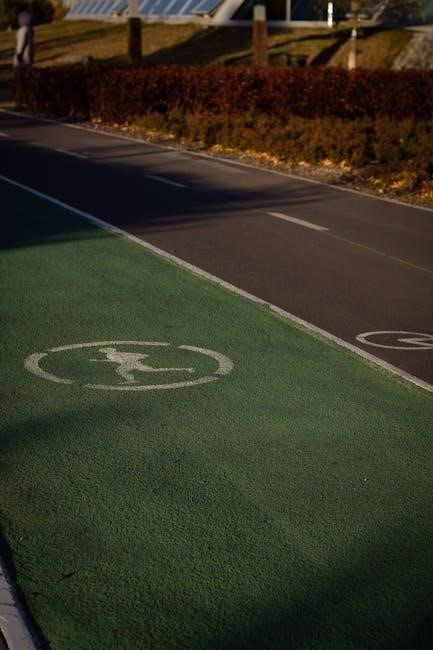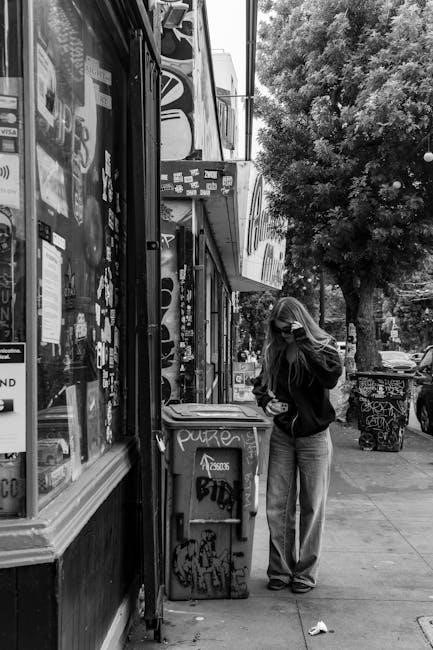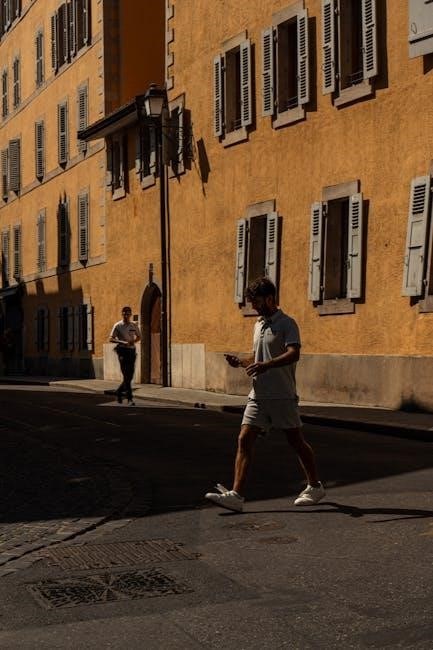The Pedestrian, a dystopian short story by Ray Bradbury, is set in 2053 and follows Leonard Mead, a man who defies societal norms by walking at night in a world dominated by television and technology. His solitary walks lead to an encounter with a robotic police car, highlighting themes of conformity, technological control, and the loss of individuality. Bradbury’s vivid imagery and haunting narrative explore a future where human connection and creativity are stifled, offering a cautionary tale about the dangers of a society reliant on technology.
1.1 Overview of the Story
The Pedestrian, set in the year 2053, follows Leonard Mead, a man who enjoys solitary evening walks in a desolate, technology-dominated city. While walking one night, he is intercepted by a robotic police car, which questions his unusual behavior. Mead’s lack of a profession and his preference for walking over watching TV raise suspicion. The story culminates in his arrest and detention at a psychiatric center, highlighting the societal pressure to conform and the erosion of individuality in a world controlled by technology and surveillance.

1.2 Ray Bradbury and His Writing Style
Ray Bradbury’s writing in The Pedestrian is characterized by vivid imagery and a poetic, descriptive style. He uses metaphors and similes to paint a stark picture of a futuristic, technology-dominated world. Bradbury’s prose is both evocative and haunting, emphasizing the isolation of the protagonist, Leonard Mead. His narrative voice often carries a philosophical tone, reflecting on themes like individuality and societal conformity. Bradbury’s ability to blend lyrical language with dystopian elements creates a unique and thought-provoking reading experience, drawing readers into a world where human connection is rare and technology reigns supreme.
1.3 Historical Context of the Story
The Pedestrian, written in 1951, reflects Ray Bradbury’s concerns about the rise of technology and societal conformity during the post-World War II era. The story’s futuristic setting in 2053 serves as a cautionary tale, critiquing the rapid advancements of the time. Bradbury was influenced by the growing popularity of television and the suburbanization of America, which he saw as isolating individuals. The narrative also mirrors Cold War anxieties about government control and the homogenization of culture. Bradbury’s vision of a dystopian future highlights his fear of a society where technology replaces human connection and individuality is suppressed.
Themes in “The Pedestrian”
The Pedestrian explores themes of conformity, technological dominance, and the erosion of individuality. Bradbury critiques a society where humans are controlled by technology and lose creative thought, emphasizing the importance of autonomy and human connection in a world increasingly dominated by machines and surveillance.
2.1 The Pressure to Conform to Social Norms
In The Pedestrian, Ray Bradbury illustrates a society where conformity is enforced through technology and societal expectations. Leonard Mead’s act of walking, a simple yet individualistic activity, is seen as abnormal in a world where people are glued to their TVs. The robotic police car’s interrogation of Mead highlights the pressure to align with societal norms, as his lack of a “profession” and absence of a TV make him a target. Bradbury warns against a culture that demands uniformity, suppressing individuality and creative thought, ultimately leading to a loss of human autonomy and freedom.
2.2 The Dangers of Technological Advancement
The Pedestrian by Ray Bradbury critiques the over-reliance on technology, depicting a society where machines enforce societal norms. The robotic police car symbolizes technological control, arresting Leonard Mead for his nonconformist behavior. Bradbury highlights how technology can dehumanize, as people are glued to TVs, indifferent to the world outside. The story warns against a future where technological advancement replaces human connection, leading to a loss of freedom and individuality. Bradbury’s vision serves as a cautionary tale about the risks of allowing technology to dominate human life and dictate societal behavior.
2.3 The Loss of Creative Thought and Individuality
The Pedestrian by Ray Bradbury illustrates the erosion of creative thought and individuality in a technology-dominated society. Leonard Mead’s love for walking and observing nature contrasts sharply with a population engrossed in television, symbolizing the loss of personal expression. Bradbury portrays a world where conformity is enforced, and unique behaviors are deemed abnormal. Mead’s arrest for his simple, creative act of walking underscores the suppression of individuality, warning against a future where people become passive consumers of media, stripped of their ability to think independently and engage with the world around them.
2.4 Government Control and Surveillance
The Pedestrian highlights government control through the robotic police car that arrests Leonard Mead for his non-conformist behavior. The car’s automated system enforces societal norms, symbolizing a surveillance state where individuality is monitored and suppressed. Bradbury critiques authoritarian regimes that prioritize order over freedom, as Mead’s arrest for walking demonstrates the extremes of governmental control. The story warns against a future where independent thought is criminalized, and citizens are conditioned to conform, reflecting Bradbury’s concern about the erosion of personal liberties in a technologically dominated society.
The Futuristic Setting
The Pedestrian is set in a desolate, technology-dominated city in 2053, where streets are empty, and people remain indoors, glued to their TVs. The automated police car symbolizes the oppressive surveillance and control of a society that values conformity over individuality, creating a chilling vision of a future where human connection is lost, and freedom is curtailed by technological advancement.
3.1 The Year 2053 and Its Implications
The Pedestrian is set in the year 2053, a futuristic era where technology dominates, and society has become increasingly isolated; Bradbury uses this setting to critique the implications of unchecked technological advancement, depicting a world where humans are disconnected from nature and each other. The year 2053 symbolizes a dystopian future where individuality is suppressed, and conformity is enforced. The story highlights the loss of creative thought and the rise of government surveillance, reflecting Bradbury’s concern about the potential dangers of a society overly reliant on technology and media.
3.2 The City and Its Technological Landscape
The Pedestrian portrays a city in 2053 where technology has transformed urban life. The streets are empty and silent, illuminated only by the faint glow of television screens in homes. People remain indoors, glued to their screens, while the city’s infrastructure is dominated by advanced technology. The absence of human interaction and the prevalence of robotic law enforcement, like the police car, highlight the city’s cold, mechanized environment. This setting reflects Bradbury’s vision of a society where technology has erased human connection, leaving behind a desolate, isolating urban landscape.
3.4 The Role of Television in Society
In The Pedestrian, television serves as a central element of societal control, dominating daily life in 2053. People are glued to their screens, passively consuming content that numbs their minds and discourages critical thought. The glow of TV lights in homes contrasts with the dark, empty streets, symbolizing a society that has abandoned outdoor activities and human interaction. Bradbury uses television to illustrate how technology can isolate individuals, turning them into passive observers rather than active participants in life. This dependency on TV reflects a broader theme of technological overreach stifling individuality and creativity.

Character Analysis
Leonard Mead is a defiant individual who challenges societal norms by walking alone at night in a world dominated by technology. The robotic police car embodies authoritarian control, while the invisible society indoors, glued to TV, symbolizes mass conformity and isolation. These characters highlight Bradbury’s exploration of individuality versus technological dominance.
4.1 Leonard Mead: The Protagonist
Leonard Mead is the protagonist of The Pedestrian, a man who defies societal norms by walking alone at night in a futuristic, technology-dominated world. His love for walking reflects his appreciation for nature and individuality, contrasting sharply with the indoor, TV-obsessed society. Mead’s defiance leads to his arrest by a robotic police car, symbolizing his resistance to conformity. His character represents Bradbury’s championing of autonomy and creative thought, highlighting the tension between human connection and technological control in a desolate, isolated world.
4.2 The Robotic Police Car: A Symbol of Authority
The robotic police car in The Pedestrian embodies the oppressive authority of a technologically controlled society. Its automated voice and relentless questioning of Leonard Mead highlight the dehumanization of law enforcement. The car’s presence underscores the theme of government surveillance and control, as it patrols the empty streets, enforcing conformity. Its interaction with Mead reveals a society where individuality is seen as a threat, and technological systems dictate human behavior. The car’s cold, mechanical demeanor contrasts sharply with Mead’s humanity, symbolizing the clash between progress and personal freedom.
4.3 The Invisible Society: People Indoors
In The Pedestrian, the people indoors symbolize a society hidden from the world, consumed by television and technological distractions. Their absence from public spaces highlights a culture of isolation and uniformity. Bradbury portrays them as ghostly figures, their faces illuminated only by TV screens, their minds disconnected from reality. This invisible society reflects a broader shift toward passive consumption and loss of human connection. Their indoor confinement contrasts sharply with Mead’s active engagement with the world, emphasizing the tension between individuality and technological control. The indoors represents conformity, while the outdoors symbolizes freedom and autonomy.
The Conflict and Its Significance
The Pedestrian revolves around Leonard Mead’s arrest by a robotic police car for walking alone at night, a act deemed abnormal in a society glued to television. This conflict underscores the tension between individuality and conformity, highlighting Bradbury’s warning against a world where technological control suppresses human freedom and creativity. The arrest symbolizes the societal pressure to conform, emphasizing the loss of autonomy in a technologically dominated future.
5.1 The Incident with the Police Car
Leonard Mead’s peaceful evening walk takes a dramatic turn when a robotic police car stops him. The car, programmed to enforce societal norms, questions his unusual activity. Mead explains his love for walking, fresh air, and observation, but the car finds his reasons insufficient. His lack of a “viewing screen” at home further arouses suspicion. Despite his defiance, Mead is forcibly taken to a psychiatric center for exhibiting “regressive tendencies.” This incident highlights the clash between individuality and a society controlled by technology, showcasing Bradbury’s critique of conformity and loss of human autonomy.
5.2 Mead’s Arrest and Its Implications
Leonard Mead’s arrest by the robotic police car symbolizes the suppression of individuality in a society governed by technology. His defiance of societal norms—walking instead of watching TV—labels him a threat. The police car, representing authoritarian control, detains him for “regressive tendencies,” highlighting the dangers of a conformist society. Mead’s arrest underscores Bradbury’s critique of a world where freedom of choice is erased, and human autonomy is replaced by technological enforcement. This event serves as a stark warning about the loss of personal freedom in a hyper-controlled future.
5.3 The Psychiatric Center: A Symbol of Control

The psychiatric center in The Pedestrian serves as a chilling symbol of societal control, where nonconformists like Leonard Mead are “reprogrammed” to fit norms. Its cold, metallic interior and antiseptic smell evoke a sense of clinical detachment, emphasizing the dehumanizing effects of technological dominance. The center represents a system that pathologizes individuality, forcing citizens to conform to a homogeneous, TV-centric society. Mead’s confinement here underscores Bradbury’s warning about the dangers of a society that prioritizes technological advancement over human freedom and creativity.

Bradbury’s Use of Imagery and Symbolism
Bradbury employs vivid imagery to depict a desolate, technology-dominated world, contrasting nature’s beauty with cold, metallic landscapes. Symbolism highlights themes of conformity and individuality through Mead’s solitary walks and the oppressive police car.
6.1 Descriptions of the City and Night
Bradbury vividly portrays a desolate city in 2053, where empty streets and cold November nights dominate. The houses resemble graveyards, their dark windows like voids, while faint TV glows hint at indoor lives. Mead’s footsteps echo on uneven sidewalks, emphasizing solitude. The city’s technological chill contrasts with nature’s whispers, as fallen leaves and frosty air evoke a sense of isolation. Bradbury’s imagery paints a stark, eerie landscape, highlighting the absence of human connection in a world consumed by technology and indoor distractions.
6.2 The Contrast Between Nature and Technology
Bradbury contrasts the natural world with the cold, technological landscape of 2053. Mead’s appreciation for the night air, fallen leaves, and the earth’s scent highlights nature’s beauty. Meanwhile, the city’s empty streets, dark houses, and robotic police car symbolize a society dominated by technology. This juxtaposition underscores Bradbury’s critique of a world where nature is neglected and human connection is lost to technological advancement, emphasizing the tension between organic life and artificial control.
6.3 The Symbolism of Mead’s Walking
Mead’s walking symbolizes individuality and rebellion against a society dominated by technology and conformity. His nightly strolls represent a longing for freedom and connection to the natural world, contrasting sharply with the indoor, TV-centric lifestyle of others. Bradbury uses Mead’s walking as a metaphor for the human spirit’s need for autonomy and self-expression. The act of walking itself becomes a defiance of societal norms, highlighting the tension between personal freedom and technological control. Mead’s defiance ultimately leads to his arrest, underscoring the consequences of nonconformity in a rigidly controlled world.

The Message of the Story
The Pedestrian emphasizes the importance of individuality, warns against over-reliance on technology, and highlights the need for human connection in a society dominated by conformity.

7.1 The Importance of Individuality
Leonard Mead’s solitary walks symbolize his resistance to societal norms, emphasizing the value of individuality in a world where conformity is enforced. Bradbury portrays Mead as a man who cherishes autonomy and self-expression, even in a society that views such behavior as abnormal. His actions highlight the importance of maintaining one’s identity and freedom of thought, contrasting with the mindless uniformity of a technology-driven culture. Through Mead’s character, Bradbury underscores the necessity of preserving individuality to prevent humanity from becoming mere shadows of its former self.
7.2 The Dangers of Over-Reliance on Technology
Bradbury’s depiction of a society dominated by technology serves as a warning about the risks of over-reliance on machines. The robotic police car and the absence of human interaction illustrate how technology can replace empathy and understanding. Mead’s arrest for walking highlights the dehumanizing effects of a world where individuality is suppressed. The story suggests that excessive dependence on technology leads to a loss of meaningful human connection and creative thought, ultimately creating a society where conformity is enforced, and freedom of expression is stifled.
7.3 The Need for Human Connection
Bradbury emphasizes the importance of human connection in a world increasingly dominated by technology. Leonard Mead’s nightly walks symbolize his quest for interaction and meaning in a society where people are isolated indoors, glued to their screens. The absence of human interaction in the story underscores the emotional isolation of modern life. Mead’s arrest by a robotic police car highlights the dehumanizing effects of a society that values technology over people. The story warns that without genuine human connection, individuals lose their sense of identity and community, leading to a hollow, mechanized existence.
Bradbury’s Other Works and Comparisons
Bradbury’s works like “Fahrenheit 451” and “Dandelion Wine” explore similar themes of technology, individuality, and societal pressures, all presented with his signature vivid imagery and poetic prose.
8.1 Similar Themes in Bradbury’s Writing
Ray Bradbury’s works often explore themes of technology’s impact on society, individuality, and the loss of human connection. In “Fahrenheit 451,” he critiques a society that bans books, mirroring the conformity seen in “The Pedestrian.” Similarly, “Dandelion Wine” reflects on nostalgia and the passage of time, while “Something Wicked This Way Comes” examines fear and morality. Bradbury’s writing consistently warns against unchecked technological advancement and the erosion of creative thought, emphasizing the importance of preserving humanity in a rapidly changing world.

8.2 Comparison with “Fahrenheit 451”
Both “The Pedestrian” and “Fahrenheit 451” by Ray Bradbury explore themes of conformity, technological dominance, and the suppression of individuality. In “Fahrenheit 451,” society bans books to control thought, while in “The Pedestrian,” walking is seen as a threat to societal norms. Both protagonists, Leonard Mead and Guy Montag, challenge the status quo, highlighting Bradbury’s concern about the loss of creative thought and human connection. These works serve as cautionary tales, warning against a future where technology and government control stifle freedom and intellectual curiosity.
8.3 Bradbury’s Vision of the Future
Ray Bradbury’s vision of the future, as depicted in “The Pedestrian” and other works, is a cautionary tale of a society dominated by technology and government control. He envisions a world where individuality is suppressed, and people are conditioned to conform to societal norms. Bradbury warns against the dehumanizing effects of technological advancement, where human connection and creative thought are replaced by mindless consumption of media; His future is one where freedom is illusionary, and autonomy is stripped away, leaving humanity in a state of emotional and intellectual barrenness. This vision serves as a stark reminder of the dangers of unchecked technological progress and authoritarian control.
The Pedestrian delivers a powerful message about individuality and the dangers of a technology-driven society. Bradbury’s vision warns against a future where freedom is an illusion, emphasizing the need for human connection and creativity.
9.1 Summary of Key Points
The Pedestrian by Ray Bradbury is a dystopian tale set in 2053, where Leonard Mead, a solitary walker, challenges societal norms. His arrest by a robotic police car underscores themes of conformity, technological dominance, and the erosion of individuality. Bradbury’s vivid imagery contrasts nature with technology, highlighting the loss of human connection. The story serves as a cautionary tale about a future where creativity and freedom are suppressed, urging readers to value autonomy and genuine human interaction in an increasingly mechanized world.
9.2 The Relevance of “The Pedestrian” Today
The Pedestrian remains strikingly relevant today, as it critiques societal trends like over-reliance on technology and the erosion of individuality. In an era dominated by smartphones, social media, and surveillance, Bradbury’s warnings about conformity and the loss of human connection resonate deeply. The story’s depiction of a society where people are glued to screens mirrors modern concerns about screen time and the decline of face-to-face interaction. Its themes of government control and technological dominance also echo contemporary debates about privacy and AI. Bradbury’s vision serves as a timeless cautionary tale for our increasingly automated world.

9.3 Final Thoughts on Bradbury’s Vision
Ray Bradbury’s vision in The Pedestrian is a haunting prophecy of a world where technology and conformity suffocate individuality. His portrayal of a society where people are glued to screens and isolated from reality feels eerily familiar today. Bradbury’s warning about the dangers of unchecked technological advancement and the loss of human connection remains timeless. His story challenges readers to reflect on the balance between progress and preserving what makes us human. Bradbury’s vision is a powerful reminder to cherish creativity, freedom, and the simple joys of life in an increasingly automated world.

